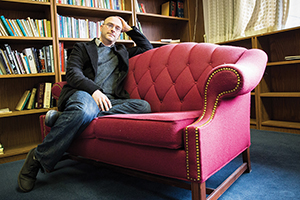
Electrifying research encourages young scientists
The young scientists bent carefully over their work – soldering connections from a resistor to a battery to an LED as they made an electrical circuit.
Not bad for third-graders, who are normally discouraged from playing with electricity.
Along the way, these Milwaukee students improved their knowledge and understanding of science, technology, engineering, the arts and mathematics (the STEAM subjects).

Chris Lawson, an assistant professor in UW-Milwaukee’s School of Education, Department of Educational Psychology, helped design and evaluate a study of the “maker experience” exhibit. It was done in partnership with Milwaukee’s Betty Brinn Children’s Museum, with a grant from the Herzfeld Foundation.
For the study, 278 students in 11 third-grade classrooms and one third/fourth-grade classroom spent five weeks learning about electrical circuits. The students worked in their classrooms and at the museum’s Be a Maker space.
“Third-grade students don’t get to do the stuff in their classrooms and their schools that they get to do in the museum,” Lawson said. “It is cool stuff. They’re making circuits. They’re learning that it’s fun and exciting to play with electricity.”
The students also learned how to use electricity to create sounds, combining and looping them to make music.
“(I liked) that we got to do cool experiments and make noise,” one student said. “That was the first time I ever made noises with random things … and played with the noises!”
Hands-on experimentation = instant gratification
“As academics, we spend a lot of time writing papers that do not get published for years,” Lawson said. “We have very delayed gratification. This was more immediate. You could see what was happening.”
Students worked with their teachers and with the museum’s education and exhibit leadership team, who helped when needed but let the students make their own discoveries. The maker area was messier than a typical classroom but gave students the opportunity to explore and experiment.
“From a theoretical standpoint, that’s how learning happens,” Lawson said. “We need to let learners go off and discover stuff on their own, make their own mistakes.”
“Our Be a Maker space was designed to help children use materials and technologies to explore STEAM concepts, build new skills and practice working independently and with others on a shared outcome,” explained Fern Shupeck, executive director of the museum.
“They were doing things people might otherwise tell them not to do, but circuits are an important concept in science,” Lawson said. “It was especially fun to work on because these are the kinds of things that are more and more being taken out of schools.”
Excited to learn
One of the goals of the project was to get students excited about learning, especially about science and technology. Studies indicate that Americans are lagging behind in these subjects, so there’s a real need for ways to get students interested and engaged in science, Lawson said. Approximately 85 percent of students involved in the project are children of color, which is significant because there’s a huge ethnic and gender disparity in the science and technology fields.
Lawson and colleague Erica Halverson, an associate professor at the University of Wisconsin-Madison, are still completing research work and preparing for publication. But preliminary results showed the students improved their knowledge of the scientific concepts taught, and the teachers and students surveyed enjoyed the experience.
“Ninety-seven percent of [the students] said they wanted to learn more in the future, and 85 percent said they’d come back to the museum’s Maker space on their own,” Lawson said.
Study results also indicated that the programs inspired educators to use maker experiences to enhance the classroom experience they provide for their students, Shupeck said.
“We are very pleased that the preliminary results of the study indicate the museum’s hands-on maker experiences improved the students’ understanding of and interest in STEAM,” said Shupeck, adding that this education is critical not only to academic success, but also to the community’s economic and workforce development.
___
Read the full 2016 UW-Milwaukee Research Report.